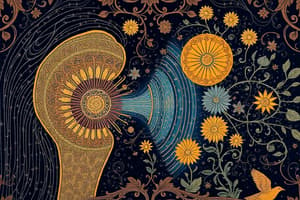Podcast
Questions and Answers
What are the three parts of the human ear?
What are the three parts of the human ear?
- Outer ear
- Middle ear
- Inner ear
- All of the above (correct)
What is the function of the cochlea?
What is the function of the cochlea?
To transduce sound vibrations into neural impulses
What does the basilar membrane do?
What does the basilar membrane do?
Moves up and down in response to sound vibrations
Which dimensions correspond to auditory perception?
Which dimensions correspond to auditory perception?
What is the primary auditory cortex area called?
What is the primary auditory cortex area called?
Higher frequencies stimulate neural signals at the base of the basilar membrane.
Higher frequencies stimulate neural signals at the base of the basilar membrane.
What type of hearing loss is caused by damage to the eardrum and ossicles?
What type of hearing loss is caused by damage to the eardrum and ossicles?
What role do binaural cues play in hearing?
What role do binaural cues play in hearing?
The perception of pitch is measured in _____ per second.
The perception of pitch is measured in _____ per second.
Flashcards are hidden until you start studying
Study Notes
Audition: The Process of Hearing
- Sound Transduction: The ear converts sound waves into neural signals.
- Outer Ear: Collects sound waves, consisting of the pinna, auditory canal, and eardrum.
- Middle Ear: Amplifies sound vibrations, containing the ossicles (hammer, anvil, stirrup).
- Inner Ear: Contains the fluid-filled cochlea, responsible for auditory transduction, and the basilar membrane with hair cells.
- Basilar Membrane: Vibrates in response to sound waves, stimulating hair cells.
- Hair Cells: Auditory receptor neurons that release neurotransmitters, starting the neural signal in the auditory nerve.
- Sound Wave Dimensions:
- Frequency: Determines pitch, measured in Hertz (Hz).
- Amplitude: Determines loudness, measured in decibels (dB).
- Complexity: Determines timbre, allowing us to distinguish different sounds with the same pitch and loudness.
Auditory Pathways in the Brain
- Cochlea: Transduces sound vibrations into neural impulses.
- Basilar Membrane: Moves in a traveling wave, with higher frequencies causing movement closer to the oval window and lower frequencies causing movement near the apex.
- Place Code: Different frequencies activate specific locations on the basilar membrane, explained by the basilar membrane's varying stiffness.
- Auditory Nerve: Carries neural signals from hair cells to the brain.
- Brain Regions:
- Thalamus: Relays auditory information.
- Area A1 (Primary Auditory Cortex): Located in the temporal lobe, processes basic sounds.
- Left Auditory Cortex: Analyzes sounds related to language.
- Right Auditory Cortex: Processes rhythms and music.
- Dorsal Auditory Stream: Processes spatial (where) sound information.
- Ventral Auditory Stream: Processes non-spatial (what) sound features.
Pitch Perception and Further Auditory Processing
- Temporal Code: The brain uses the timing of action potentials in the auditory nerve to determine pitch, particularly for lower frequencies.
- Timbre: The complex texture of sound, determined by the relative amounts of different frequency components.
- Sound Localization:
- Binaural Cues: Differences in sound arrival time and intensity at the two ears.
- Time Difference: Effective for locating low-frequency sound sources.
- Intensity Difference: Higher frequencies are more intense at the closer ear.
Hearing Loss
- Conductive Hearing Loss: Damage to the eardrum or ossicles, preventing sound waves from reaching the cochlea.
- Sensorineural Hearing Loss: Damage to the cochlea or auditory nerve, affecting the conversion of sound waves into neural signals.
Studying That Suits You
Use AI to generate personalized quizzes and flashcards to suit your learning preferences.




